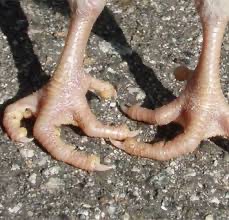Crooked Toes in Poultry
Our American Poultry Association Standard of Perfection reflects that a crooked toe is a defect that results in a .5 to 2 point deduction per toe. Are you curious about the cause of crooked toes in poultry? Numerous scientific studies have been completed on the defect. I reviewed several of the studies and have summarized the results below.
Nestor (1971) found the frequency of offspring with crooked toes from parents of which at least one had them was more than double the frequency among offspring of parents with normal toes (10.6% vs. 4%). A scientific study completed from 1943-1948 found that eliminating birds with crooked toes as breeding stock led to reduced occurrences (0.28%-5.00%) of the condition while selection for it increased occurrences (14.7%-97.1%) of the condition (Hunt, et. al, 1949). These studies point to heritability as a causal factor of crooked toes.
A study in 1949 reported that insufficient heat leading to considerable competition among chicks for warm spots, crowding under a heat source, and smooth, slick floors increased the occurrence of crooked toes. Another study that was completed in 1958 found that cold floors, hard-packed litter, slick paper placed on the litter, slow hatching and wire floors all contributed to the development of a high incidence of this condition (Balloun, S., 1958). These studies indicate improper management practices are a causal factor of crooked toes.
2800 chicks were studied in Denmark and it was found that leg problems were significantly influenced by body weight. Positive correlations (r > 0.20) were found between crooked toes and body weight in this particular study. (Sanotra, G et. al, 2001). A study in 1976 found that birds grown on continuous light had significantly more leg abnormalities than those grown on intermittent light regimes (Buckland, R et al., 1976).
A study in 1976 found that birds grown on continuous light had significantly more leg abnormalities than those grown on intermittent light regimes (Buckland, R et al., 1976).
Hicks (1949) reflected that crooked toes is caused by a riboflavin deficiency in the diet of the chicks or of the breeding stock producing them. During a study in 1984, diets containing either 22% or 30% protein were supplemented with a vitamin mix where 1 of 11 added vitamins were singly eliminated from the mix. Male, day-old broilers were fed these diets to 3 weeks of age, and weight gains, feed utilization, and leg problems were recorded. A Niacin-deficient diet gave a high percentage of birds with deformed legs including crooked toes and problems of mobility (Summer Et al., 1984). These two studies elude to a nutritional cause of crooked toes.
A study completed in 2009 reflected that elevated incubation temperatures and oxygen concentrations below 21% during the last days of embryo development can negatively affect normal development of leg bones and development of other tissues and organs that influence leg health and locomotion. Fieldwork during this particular study demonstrated that proper incubation conditions may reduce leg health problems such as crooked toes. Low early incubation temperature and transportation stress were also found to increase the incidence of leg problems in this study. (Oviedo-Rondón et al., 2019).
Campo (2019) found that crooked toes resulted in greater heterophil-to-lymphocyte ratio, further indicating stressfulness of birds as a factor influencing the occurrence of this condition.
In closing, a few of the factors that have been found to be causal of this condition are heritability, management practices, lighting regimes, nutritional deficiencies, incubation conditions, body weight and stressfulness of birds.
References:
Hicks, A. F. and Lerner, I. M. (1949). Hereditary crooked toes in chickens. Poultry Science, 28(4), 625-626. ISSN 0032-5791. https://doi.org/10.3382/ps.0280625.
Balloun, S. The problem of “lame” chickens and turkeys. Iowa State Univ. Vet 20, 93-95, 1958.
Buckland, R. D.E. Bernon, A. Goldrosen, Effect of Four Lighting Regimes on Broiler Performance, Leg Abnormalities and Plasma Corticoid Levels, Poultry Science, Volume 55, Issue 3, 1976, Pages 1072-1076, ISSN 0032-5791, https://doi.org/10.3382/ps.0551072.
Campo, J, M.T. Prieto. Associations among fluctuating asymmetry, duration of tonic immobility, heterophil-to-lymphocyte ratio, and one-legged standing, crooked toes, or footpad dermatitis in chickens, Poultry Science, Volume 88, Issue 1, 2009, Pages 65-71, ISSN 0032-5791, https://doi.org/10.3382/ps.2008-00251.
Hicks, A. I. Michael Lerner. Hereditary Crooked Toes in Chickens, Poultry Science, Volume 28, Issue 4, 1949, Pages 625-626, ISSN 0032-5791, https://doi.org/10.3382/ps.0280625.
Hicks, A. Crooked toes: Poultry defect may be hereditary nutritional or managemental in type. 1949. Calif Agr 3(10):14-15.
Hollands, K. G. (1956). A genetic analysis of the crooked toes defect in chickens (T). University of British Columbia. Retrieved from https://open.library.ubc.ca/collections/ubctheses/831/items/1.0106328
Nestor, K. Crooked Toes in Turkeys, Poultry Science, Volume 50, Issue 6, 1971, Pages 1887-1888, ISSN 0032-5791, https://doi.org/10.3382/ps.0501887.
Oviedo-Rondón, E. M.J. Wineland, J. Small, H. Cutchin, A. McElroy, A. Barri, S. Martin, Effect of incubation temperatures and chick transportation conditions on bone development and leg health, Journal of Applied Poultry Research, Volume 18, Issue 4, 2009, Pages 671-678, ISSN 1056-6171, https://doi.org/10.3382/japr.2008-00135.
Sanotra, G., Lund, J., Ersbøll, A., Petersen, J., & Vestergaard, K. (2001). Monitoring leg problems in broilers: A survey of commercial broiler production in Denmark. World’s Poultry Science Journal, 57(1), 55-69.
Summers JD, Shen H, Leeson S, Julian RJ. Influence of vitamin deficiency and level of dietary protein on the incidence of leg problems in broiler chicks. Poultry Science. 1984 Jun;63(6):1115-21. doi: 10.3382/ps.0631115. PMID: 6739402.
